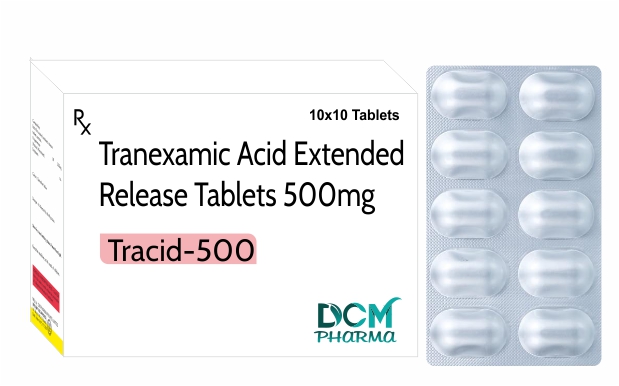Therapeutic Indication
● Bleeding
● Hereditary Angioedema
● Chronic heavy menstrual bleeding
Pharmacology
Mechanism of Action:
Tranexamic acid is an antifibrinolytic that competitively inhibits the activation of plasminogen to plasmin. Tranexamic acid is a competitive inhibitor of plasminogen activation, and at much higher concentrations, a noncompetitive inhibitor of plasmin, i.e., actions similar to aminocaproic acid. Tranexamic acid is about 10 times more potent in vitro than aminocaproic acid. Tranexamic acid binds more strongly than aminocaproic acid to both the strong and weak receptor sites of the plasminogen molecule in a ratio corresponding to the difference in potency between the compounds. Tranexamic acid competitively inhibits activation of plasminogen (via binding to the kringle domain), thereby reducing conversion of plasminogen to plasmin (fibrinolysin), an enzyme that degrades fibrin clots, fibrinogen, and other plasma proteins, including the procoagulant factors V and VIII. Tranexamic acid also directly inhibits plasmin activity, but higher doses are required than are needed to reduce plasmin formation.
Absorption: Absorption of tranexamic acid after oral administration in humans represents approximately 30 to 50% of the ingested dose and bioavailability is not affected by food intake.
Volume of distribution: 9 to 12 L
Protein binding: The plasma protein binding of tranexamic acid is about 3% at therapeutic plasma levels and seems to be fully accounted for by its binding to plasminogen (does not bind serum albumin).
Metabolism: Only a small fraction of the drug is metabolized (less than 5%).
Route of elimination: Urinary excretion is the main route of elimination via glomerular filtration.
Biological half-life in the joint fluid is about 3 hours.
Side Effects
Common side effects include:
● Nausea.
● Diarrhea.
● Stomach pain or discomfort.
● Vomiting.
● Chills.
● Fever.
● Severe headache (throbbing)
● Back or joint pain
Contraindication
Not to be used in following conditions:
● Active intravascular clotting (contraindicated)
● Subarachnoid hemorrhage, (may increase cerebral ischaemic complications)
● Hypersensitivity to tranexamic acid
● Upper renal tract bleeding,(relatively contraindicated due to the possibility of clot retention)
Interaction
The following medications may interact with tranexamic acid:
● Anticoagulants such as warfarin, heparin
● Drugs that prevent bleeding including factor IX complex, anti-inhibitor coagulant concentrates
● Tretinoin
● Estrogens
● Hormonal birth control, such as pills, patch, ring
